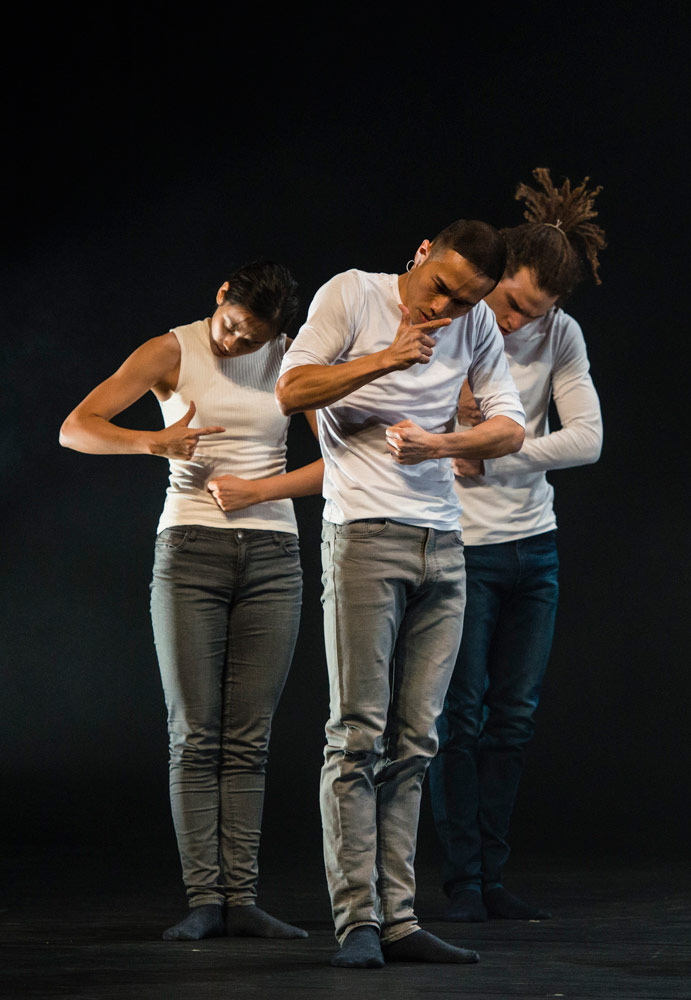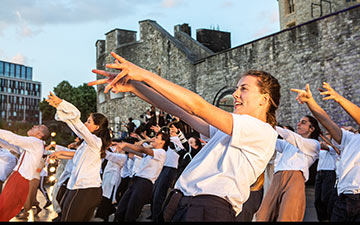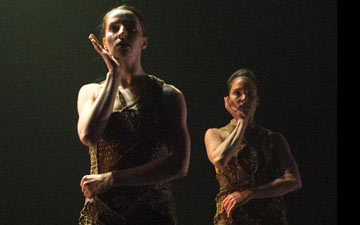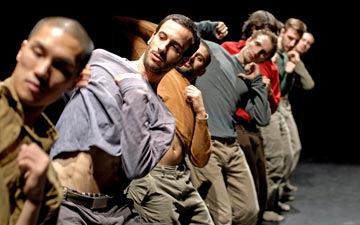
© Gabriele Zucca. (Click image for larger version)
Hofesh Shechter Company
barbarians trilogy: barbarians in love, tHE bAD, Two completely different angles of the same fucking thing
★★✰✰✰
London, Sadler’s Wells
6 July 2016
www.hofesh.co.uk
www.sadlerswells.com
A psychology degree might have been helpful in analysing Hofesh Shechter’s first triple bill; here returning to Sadler’s Wells where it premiered, last September. Many things can perhaps be read into this atmospheric, mood-swinging triptych but the most obvious is that it appears to lay bare the inner sanctum of Shechter’s psyche. So much so that one might easily imagine the opening voiceover conversation between the actress, Natascha McElhone and Shechter (his voice now disguised by a synthesiser) to be between a psychiatrist and her patient, in which his fictional confession to infidelity appears to open up a can of inner demons.
The three works appear to be inter-connected, directly or indirectly, in random ways. This is sometimes consciously overt, such as when the dancers from the first two parts appear – clad in the same costumes – as a backdrop to the duet in the final section. Elsewhere, it is obvious only atmospherically; in the darkness of the stage setting and in the often uncomfortably loud noise.
Perhaps the best clue to these associations and the choreographer’s disorderly intentions comes in the bastardisation of grammar and the use of profanity in his choice of titles: the uncompromising lower case for the barbarians in love; the misapplied Capital Lock in tHE bAD (happens to us all, Hofesh); and the casually unnecessary use of the “F” word in Two completely different angles of the same fucking thing.
The whole affair is, it has to be said, an assault on the senses. Much of the time it’s hard to see anything in the indistinct gloom and most of the time one regrets not bringing ear plugs. Shechter’s shows are generally full of “shouting movement” and the heavy drumming of his own composition; but here the noise doesn’t stop in the connection between the ear and the brain, travelling like a throbbing army of jiving, blood-sucking caterpillars slurping their way through one’s veins. It is noise that travels up your legs, through your guts and reverberates in your chest.

© Foteini Christofilopoulou. (Click image for larger version)
The auto-biographical nature of the opening work crosses the boundary into a self-indulgence, which nonetheless suits the anarchical intentions of breaking – or, at least deconstructing – some norms of dance theatre in a proscenium setting. barbarians in love was first performed to close The Associates programme at Sadler’s Wells, last year, and it holds many isolated and contrasting moments of aesthetic beauty and bludgeoning visceral impact. It also enjoys the underlying, occasional and metaphorical cuddle of a baroque influence, as the dancers float in and out of a classical language in the eighteenth century compositions of François Couperin that interject with the thematic score by Shechter himself.
Slick harmony in the unified movement for the six dancers, dressed in white, was punctuated by stillness and the performers themselves ended the work apparently naked, moving with imperceptible stealth and barely lit in a soft strip of dusk-like illumination coming from the side. barbarians in love has undergone some iterative changes over the past 18 months and seems tighter-knit than before.

© Foteini Christofilopoulou. (Click image for larger version)
The second part – tHE bAD – is something most writers can empathise with since it was created overnight, in a single session. The five dancers appear in the least likely outfits one can imagine for a Shechter work and the skin-tight, gold bodysuits were apparently chosen for that very reason. It offers all the evidence to show that it was quickly constructed in the wee small hours, including a slightly amusing contretemps amongst the dancers, as Diogo Sousa tries to get his moment in the limelight only to be bumped off it again, quickly, by the other four; simple but repetitive fast-moving steps, that burst out into loping arms and little hops; and a continuing mix of pulsating noise again juxtaposed with gentle baroque music.
Explaining tHE bAD in a recent interview, the choreographer said that it ‘was an attempt to try and make a piece without thinking.’ The lack of planning or forethought is easily discernible but it remains nonetheless a compelling and arresting piece.
Shechter has also revealed that the final part is the point of the whole evening and that the preceding pieces are merely the preparation for this denouement. This, I failed to see, either then, or now, with the benefit of hindsight. Perhaps this is because the choreographer himself didn’t intend this holistic end to the trilogy; it’s merely how it struck him when he first saw the whole evening performed.
Why the man (Frédéric Despierre) should be dressed in lederhosen is not clear. The dance lacks the compulsive drive of the preparatory works and – to be blunt – I was quickly alienated by the disconnected movement and dulled into insensitivity by an often hostile environment of sound and vision. I saw little point for reintroducing the earlier dance crews for uneventful encores.
“I’m a 40 year-old man, looking for a thrill”, says the speech-synthesised voice of the choreographer in his unseen conversation with McElhone. His introduction of age into the early part of the performance is perceptive since the core of Shechter’s fan-base seems to largely comprise young people, especially those who have trained in dance. Here is an artist that combines hi-energy music and dance to thrill a legion of young fans and this barbarians trilogy clearly – and noisily – fuelled their enthusiasm. But, not for the first time, I was left somewhat unconvinced by it all.

















I agree with much that is said here – especially regarding the third part. The first piece suffered too, much like the cacti of NDT, of some complacency with their pomo, ironic escapism – but this, for me, was largely redeemed by an adventurous staging (those lights!!!) and a fine unison.
If I may contribute a friendly criticism, flaunting your disregard for electronic dance music (in this piece, Drum and Bass) by calling it “noise” does not contribute much: it seems less -today- to reflect any generational divide than to claim a position of authority. “Noise” as a style appear regularly in contemporary dance, most recently in Chouinard’s Henri Michaux: Mouvements.